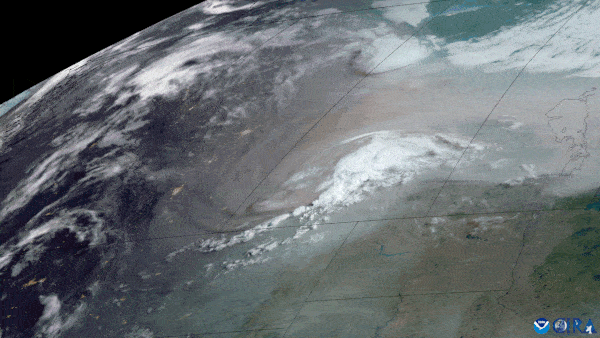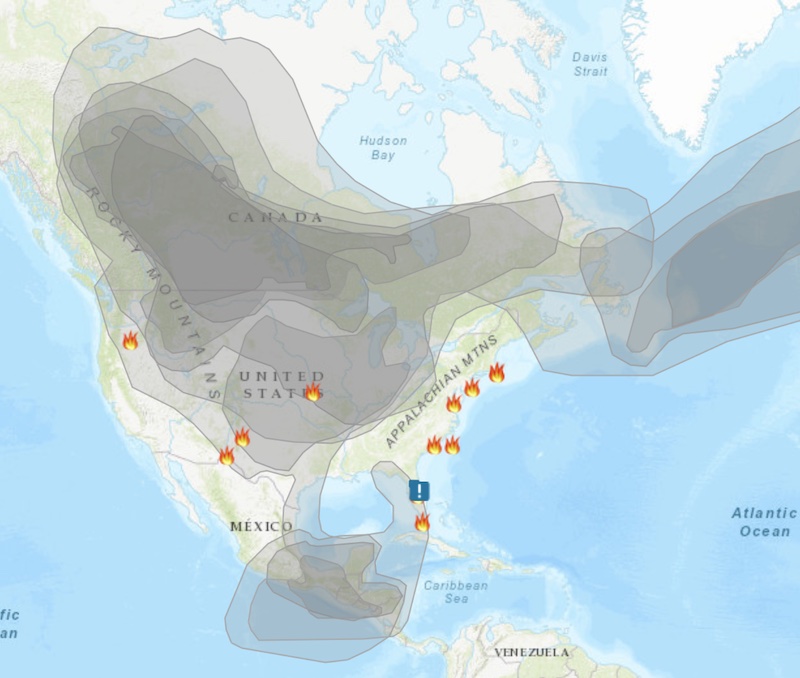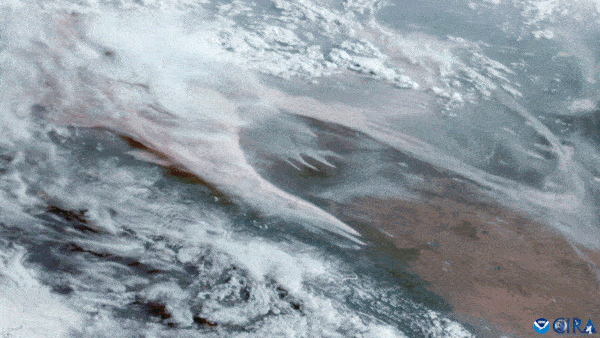
Canadian wildfires continue to rage
Update: On May 21, 2023, Canadian wildfires were still burning in boreal forests, while the smoke poured across the provinces and into much of the U.S. Many of the northern tier U.S. states had smoky skies and red suns over the past week. Some of the smoke eventually sank through the atmosphere, creating what looked like foggy conditions as the smoke settled near the ground. But as fires continue to burn in Canada, more smoke billows across North America. Meteorologists even saw a large swirl of smoke, imitating a cyclonic storm swirling around a low-pressure system. Places in Canada and the U.S. face air quality alerts with these ongoing early-season wildfires.
As of Sunday morning, May 21, British Columbia reported 89 active wildfires, Alberta had 86, and Saskatchewan had 27.
Wildfire #smoke is entrenched over the state of Michigan today, both peninsula's, as well as #LakeMichigan, #LakeSuperior and #LakeHuron. Get updates of this #GreatLakes scene at https://t.co/T0wpo0DqXd #MIwx pic.twitter.com/qMRrzNSjfh
— UW-Madison CIMSS (@UWCIMSS) May 21, 2023
We've now eclipsed TWO MILLION hectares of wildland burned across Canada ???
Both Alberta and Saskatchewan quickly approaching (or surpassing) a million a piece – and this by May long weekend.
Quickly becoming one of the worst fire seasons on record. #Abfire #ABWildfire… pic.twitter.com/4zRe2htNCq
— Kyle Brittain (@KyleBrittainWX) May 21, 2023
Update: remarkable "smoke cyclone"/ "smokestorm" has now moved south into central U.S., crossing the Canadian border near the MT/SD border. This low pressure system has entrained a massive amount of smoke from numerous large boreal forest fires in central Canada.#MTwx #SDwx #COwx https://t.co/Z80zPIFciJ pic.twitter.com/SzMk1zzq7e
— Daniel Swain (@Weather_West) May 21, 2023
The Minnesota Pollution Control Agency has issued an air quality alert for the entire state of Minnesota due to wildfire smoke.
The alert will be in effect until 6:00 a.m. on Friday.https://t.co/dJq4UEFZGo
— ABC 6 News – KAAL TV (@ABC6NEWS) May 18, 2023
Canadian wildfires the week of May 14, 2023
On May 15, 2023, Canadian wildfires were still raging in Alberta and neighboring provinces of Saskatchewan and British Columbia. In addition, British Columbia was experiencing an early season heatwave. On May 15, there were 89 active fires in Alberta. British Columbia had 56 active wildfires, while Saskatchewan had 35. Smoke from the Canadian fires was pouring over the border into the skies of North Dakota and Minnesota.
See those "clouds" in Canada?
That is actually a large expanse of smoke from fires within Canada. This smoke will move over the Northern Plains and Upper Midwest starting this evening.
Expect hazy skies and perhaps reduced air quality through at least Tuesday. #ndwx #mnwx pic.twitter.com/8ZTzq6Mmf4
— NWS Grand Forks (@NWSGrandForks) May 15, 2023
Canadian #wildfire smoke today (May 14th) via #GOESEast. https://t.co/BK3fzm1FaN pic.twitter.com/Paj3RQXPiL
— UW-Madison CIMSS (@UWCIMSS) May 15, 2023
????Updates on #AlbertaWildfires:few cloudy/rainy days gave relief to burned areas,the latest 12hrs evolution by #GOES16 shows a new strength of active 87 #wildfires,new large ones in #Saskatchewan and massive smoke covering more than 1.2 M of Km2 #ClimateEmergency #Canada pic.twitter.com/Pq8OGGSgbG
— SatWorld (@or_bit_eye) May 15, 2023
British Columbia is popping off after everyone was sent to Alberta.
This is the G80291 Fire near Fort St. John B.C., Canada. There may be a 2nd round of resource requests coming soon…
Thanks to the Subscriber that sent this in. ?? #wildfire pic.twitter.com/bLygKCTiRo
— The Hotshot Wake Up (@HotshotWake) May 14, 2023
Alberta wildfires and swirling smoke
Wildfire season in Alberta, Canada, typically begins in May. But this year has had an explosive beginning. This forest-covered province has endured a hot, dry spring. And, by last week, wildfires billowing up from the forests led to evacuations of more than 29,000 people, and a state of emergency beginning for Alberta on May 6, 2023. NASA Earth Observatory reported that the fires have been so intense that they’ve produced towering chimneys of smoke in the form of pyrocumulonimbus clouds.
The smoke from all these fires has swirled through the atmosphere and across the northeastern United States, resulting in some colorful sunrises and sunsets.
You can follow along with the progress of the fires and suppression efforts at the Alberta Wildfire Status Dashboard.
Neighboring provinces of British Columbia and Saskatchewan are also experiencing some wildfires.
Here is what fires in Alberta, Canada can do to a New England sunrise. https://t.co/tXPrd2mLH6
— Jim Cantore (@JimCantore) May 9, 2023


Wildfire news from Twitter
A wildfire in the Edson forest area is currently burning out of control 34 km south east of the town of Edson. If you have any smoke-related health concerns, please contact 8-1-1. You can find the most up-to-date information at https://t.co/NwsLJqe7ks. pic.twitter.com/wQz4HND4pp
— Alberta Wildfire (@AlbertaWildfire) May 6, 2023
The recent fires in Alberta have created a large swath of smoky skies over the Northeast U.S. pic.twitter.com/yibPWqsfAO
— CIRA (@CIRA_CSU) May 9, 2023
Now: There are 89 active fires in Alberta, Canada. Active area burned is ~1 million acres!! In the past 5 years the average burned area to date only +-1000 acres. Southern Canada has been super dry the past few months. A 4 sigma heat ridge this weekend will compound the issues! pic.twitter.com/rdNJ90kEgG
— Jeff Berardelli (@WeatherProf) May 9, 2023
Fires in Russia
Meanwhile, forests in Russia’s Ural Mountains and Siberia are also on fire. The boreal forest fires in Siberia have currently burned around 130,000 acres. In Omsk, Siberia, residents are under a state of emergency. The Washington Post said that Russian officials indicated that some people have been killed by the fires, but they didn’t specify how many or where.
Siberia is on fire: #Copernicus #Sentinel3 detected on May 9th multiple #wildfires across 4 Regions. Over 130.000 acres of forests in #Russia's #Sverdlovsk region were still burning and large areas have been engulfed by smoke. #Siberia #Tyumen @WMO pic.twitter.com/xZrffstAmq
— ADAM Platform (@PlatformAdam) May 9, 2023
Siberia is on fire! Forest fire in Shadrinsky District of Kurgan oblast@Pierre_Markuse @m_parrington @PlatformAdam pic.twitter.com/MhYLz7Q4sc
— Kirill Bakanov (@WeatherSarov1) May 7, 2023
BREAKING! Catastrofic fires near Kurgan and in Kurgan city area, Siberia. Aviation of the Ministry of Emergency Situations was urgently deployed to the city.#Wildfires pic.twitter.com/6FRSGIJtpd
— Kirill Bakanov (@WeatherSarov1) May 7, 2023
Bottom line: Canadian wildfires continue to rage, with the provinces of British Columbia, Alberta and Saskatchewan producing smoke that is pouring into the U.S.
Read more: Wildfires turn world’s largest forests into carbon emitters











